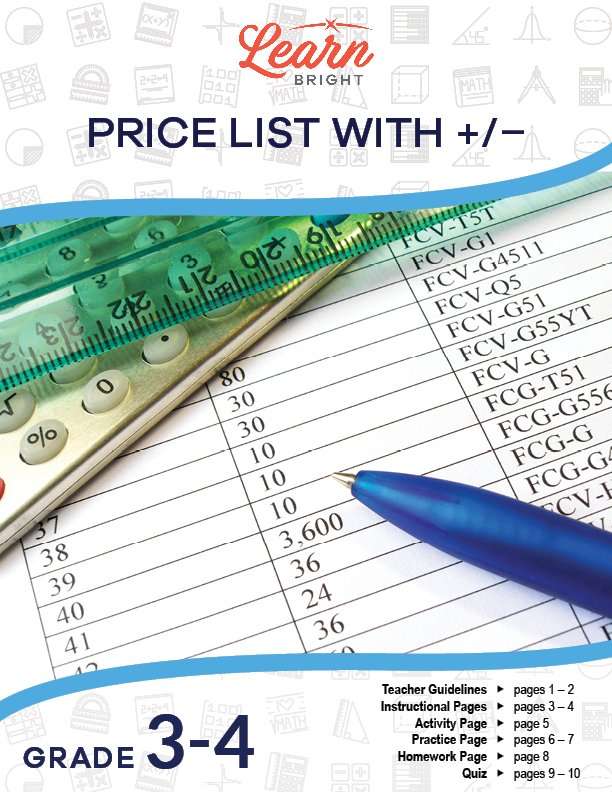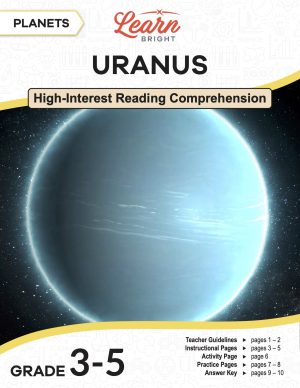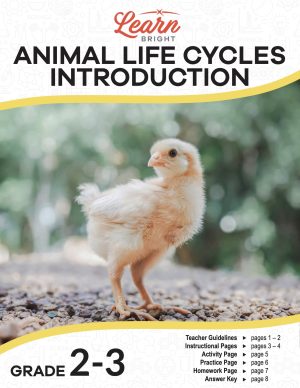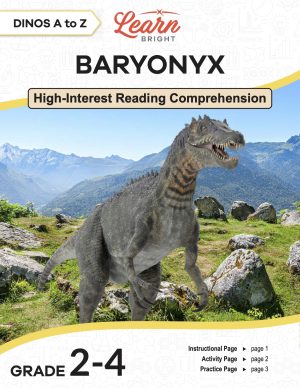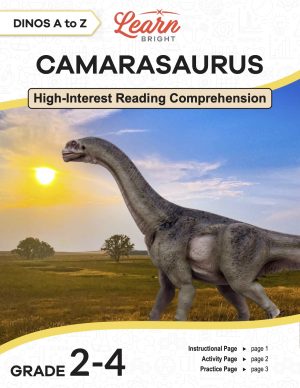Description
What our Price List with +/– lesson plan includes
Lesson Objectives and Overview: Price List with +/– teaches students how to read and create price lists with + and -. At the end of the lesson, students will be able to analyze whether they are able to purchase a product or service based on a specific amount of money. This lesson is for students in 3rd grade and 4th grade.
Classroom Procedure
Every lesson plan provides you with a classroom procedure page that outlines a step-by-step guide to follow. You do not have to follow the guide exactly. The guide helps you organize the lesson and details when to hand out worksheets. It also lists information in the blue box that you might find useful. You will find the lesson objectives, state standards, and number of class sessions the lesson should take to complete in this area. In addition, it describes the supplies you will need as well as what and how you need to prepare beforehand.
Options for Lesson
Included with this lesson is an “Options for Lesson” section that lists a number of suggestions for activities to add to the lesson or substitutions for the ones already in the lesson. One optional addition to the lesson activity is to have your students use the internet to find items or services they want to purchase to use for the activity. If you want to extend the lesson, you can discuss savings and determine how long students will need to save in order to purchase an item or service. Another optional addition to this lesson is to discuss spending decisions with your students, including planned versus unplanned. Finally, if you have students who struggle with the lesson, you can round items to the closest dollar amount.
Teacher Notes
The teacher notes page includes lines that you can use to add your own notes as you’re preparing for this lesson.
PRICE LIST WITH +/- LESSON PLAN CONTENT PAGES
Price List +/-
The Price List with +/– lesson plan includes two content pages. When you spend money, you need to consider what you want to buy and how much money you have. To purchase something like an item or service, you pay money for it. When you pay money for an item or service, you’re spending that money.
You can spend your money on lots of different things! For example, you might spend money on a microwave, nail polish, or eating lunch or dinner at a restaurant. Before purchasing something, you need to have enough money to pay the person or store. If you don’t have enough money, you can’t make your purchase. You can pay for an item or service using cash, credit, or a check.
Examples
Let’s look at an example. Reid wants to purchase an adidas soccer ball before the new season starts. He has saved $32. The soccer ball costs $40. Does he have enough money to purchase the soccer ball?
Reid does not have enough money because the amount of money he has saved ($32) is less than the cost of the soccer ball ($40). However, there are three weeks left until the season starts and Reid decides that he will save his allowance each week until he has enough to buy it. If Reid receives $4 a week for allowance, will he be able to save enough money to buy the soccer ball before the season starts?
In week one, he’ll save $4. In week two, he’ll save an additional $4 for a total of $8. Finally, in week three, he’ll save an additional $4 for a total of $12. Therefore, he’ll have a total of $44 ($32 + $12). The total amount he’ll have saved ($44) is more than the cost of the soccer ball ($40) so he will have enough money to buy it.
Let’s look at another example. Jane goes to the toy store with the money she saved from walking her neighbor’s dog. She has $20 in her pocket. She wants to buy ear candy earbuds for $3, a remote control car for $11, and a slimy goop launcher for $5. Can she buy all of the items she wants?
Let’s add up the cost of the items she wants: $3 + $11 + $5 = $19. The amount of money she has ($20) is more than the cost of the three items ($19). Therefore, she does have enough money to buy all of them!
Before you purchase items, you need to add up how much they will cost and see if you have enough money to buy them all. If the cost of the item or items is more than the amount of money you have, you can’t purchase them. But if the the cost is less than the amount of money you have, you can!
PRICE LIST WITH +/- LESSON PLAN WORKSHEETS
The Price List with +/– lesson plan includes four worksheets: an activity worksheet, a practice worksheet, a homework assignment, and a quiz. You can refer to the guide on the classroom procedure page to determine when to hand out each worksheet.
PURCHASES ACTIVITY WORKSHEET
The activity worksheet asks students to decide what they would purchase with different amounts of money.
ADDING PRICE TAGS PRACTICE WORKSHEET
For the practice worksheet, students will add the price tags of the items shown. They will then determine if they have enough money to purchase those items.
PRICE LIST HOMEWORK ASSIGNMENT
The homework assignment asks students to make a list of what they would purchase with $100. They should include the price of each item and make sure not to go over their spending limit of $100.
QUIZ
This lesson also includes a quiz that you can use to test students’ understanding of the lesson material. For the quiz, students will read the example menu shown on the worksheet and decide what they would order with $17.00.
Worksheet Answer Keys
This lesson plan includes answer keys for the practice worksheet and the quiz. If you choose to administer the lesson pages to your students via PDF, you will need to save a new file that omits these pages. Otherwise, you can simply print out the applicable pages and keep these as reference for yourself when grading assignments.

